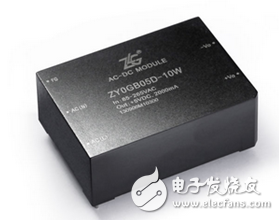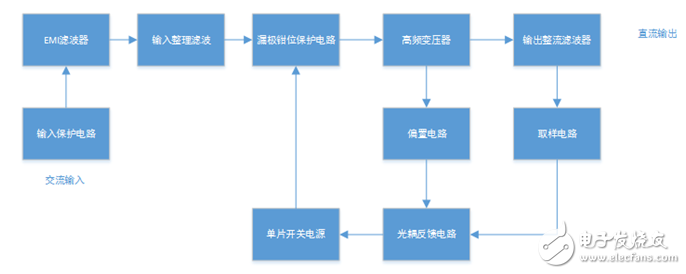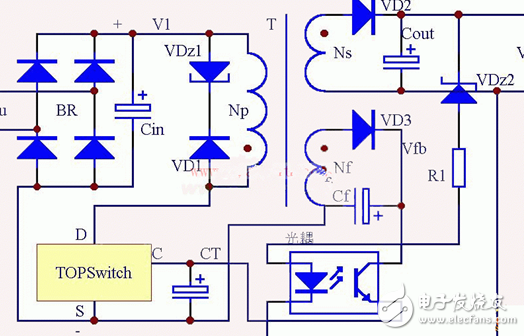With the rapid development of my country's industry, switching power supplies have gradually stepped onto the world stage, and the volume of power supplies has gradually become modularized and miniaturized, and the immunity of power supplies has become stronger and stronger. How does the switching power supply realize voltage control? What is the internal structure? Let’s take a quick look at it.
1. What is a switching power supply
Switching power supply is the abbreviation of switching regulated power supply, generally refers to an AC-DC converter whose input is AC voltage and output is DC voltage. The power switch tube inside the switching power supply works in the high-frequency switching state, and consumes very low energy. The efficiency of the power supply can reach 75%~90%, which is twice that of the ordinary linear regulated power supply (linear power supply).
Speaking of linear power supply (as shown in Figure 1), what is the difference between it and switching power supply? The popular point is that the voltage regulation of the linear power supply can be regarded as the voltage regulation of the resistance value, which is equivalent to adjusting the sliding rheostat to change the voltage. The switching power supply can be regarded as changing the voltage by adjusting the switching frequency.

Figure 1 Linear power supply
Second, the classification of switching power supplies
Non-power frequency transformer type switching power supply
The non-power frequency transformer-type switching power supply uses a small high-frequency transformer to replace the bulky power frequency transformer, and the experiment is isolated from the power grid. Since the internal components of the switching power supply work in a high-frequency switching state, the energy consumed by itself is very low, and the power supply efficiency is doubled compared with ordinary linear power supplies.

Figure 2 Block diagram of switching power supply
Switching regulator
Switching regulator is a switch type integrated voltage regulator. It integrates PWM controller, power output stage, protection circuit, etc. in one chip. The efficiency of the regulator can reach more than 90%, and some can continuously adjust the output. Voltage, suitable for manufacturing switching power supplies ranging from tens of watts to hundreds of watts.
Single chip switching power supply
The single-chip switching power supply integrates the main circuits of the switching power supply in the chip, which can realize output isolation, pulse width modulation and multiple protection functions, and its integration is the highest. The single-chip switching power supply adapts to 85~265V, 47~400HZ alternating current through the input rectifier filter. And it has the advantages of high integration, high cost performance, simplest peripheral circuits, best performance indicators, etc., and has become the preferred integrated circuit for the development of medium and small power switching power supplies, precision switching power supplies and modular switching power supplies below 600W.

Figure 3 Monolithic switching power supply module
3. Working mode of switching power supply
Switching power supplies are classified according to control principles, and can be classified into the following 4 categories:
1) Pulse width modulation (PWM for short, pulse width modulation) type: Simply put, it is to achieve the purpose of voltage stabilization by adjusting the pulse width, and the core is the PWM controller. The application of switching power supply in this way is the most common, and its duty cycle adjustment range is large, and the PWM can also be synchronized with the clock of the main system.
2) Pulse frequency modulation (referred to as PFM, or pulse frequency modulation): Similar to pulse width debugging, it achieves voltage stabilization by adjusting the switching frequency, and its core is the PFM controller. This method is suitable for portable equipment, which reduces the quiescent current of the control chip under low duty cycle and low frequency conditions.
3) Pulse density modulation (referred to as PDM, or pulse density modulation) type: Its characteristic is that the pulse width is constant, and the purpose of voltage stabilization is achieved by adjusting the number of pulses. It adopts zero-voltage technology, which can significantly reduce power switch tube losses.
4) Hybrid modulation: it is a combination of PWM and PFM. Switching period, switching period and pulse width are adjustable
It should be pointed out that the PWM controller can be used as an independent integrated circuit, can also be integrated in a switching regulator, or integrated in a switching power supply. Among them, the switching regulator is a DC-DC converter, and the switching power supply is generally an AC-DC converter. As shown in Figure 4:

Figure 4 Monolithic switching power supply composition
From the figure, we can see that removing the front-end rectification and filtering part can be regarded as a DC-DC converter, plus the front-end rectification and filtering part is an AC-DC converter.
Fourth, the basic principle of switching power supply
The basic principle of switching power supply is shown in Figure 5. It is mainly composed of the following 7 parts:
1) Input rectifier filter, including rectifier bridge and input filter capacitor;
2) Monolithic switching power supply, including power switch tube and controller (including oscillator, reference voltage source, error amplifier and PWM comparator), MOSFET;
3) Drain clamp protection circuit;
4) High frequency transformer;
5) Output rectifier filter;
6) Optocoupler feedback circuit;
7) The bias circuit provides bias voltage to the photosensitive transistor of the optocoupler.

Figure 5 Basic principle of monolithic switching power supply
Five, principle analysis
The principle of voltage stabilization is analyzed as follows:
When V rises due to some reason, the current on the LED increases, and the emitter current of the receiving tube rises through the optocoupler, which in turn makes the control terminal current of TOPSWITCH larger and the duty cycle smaller, causing V to drop. , So as to achieve the effect of voltage stabilization.
Six, summary
From the above, we can see that the switching power supply, as the best player in the power industry today, has a long life cycle and obvious advantages. From the operating principle, many factors will affect the quality of the switching power supply, and the increase of other protection circuits will also make the safety of the switching power supply higher, and the choice of isolation will also affect the degree of response of the power supply. ZLG Zhiyuan Electronics’ power modules take into account the power needs of the broad business community, both in terms of power supply volume and power supply safety, to ensure the stable output of the power supply circuits of the design boards of major companies, provide power supply design support, and achieve real customers and manufacturers of interaction.
Solar Street Light,High Quality Solar Street Light,Solar Street Light Details, CN
Wuxi Shengda Yukun Energy Development co.,Ltd , https://www.xlite-solarlight.com